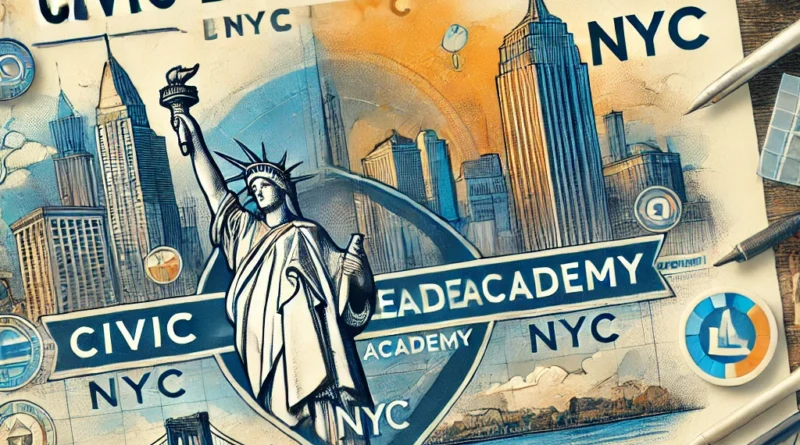Designing the Civic Leadership Academy Logo NYC: Behind the Creative Process
The academy’s brand is embodied in its image. It tells a story about the organization’s beliefs. It is not just a creative work but a powerful overall expression that consists of color, form, and typeface.
This is the stage where we will detail how the Civic Leadership Academy logo was created. From brainstorming ideas to designing processes to the final design, bring us through the details.
There is also the element of meaning how each item of the logo was chosen. Each element such as the colors, shapes, and fonts carries the message of the purpose and philosophy of the academy.
In addition we will show how the logo aids in the branding and marketing of the academy. The impression that people have and the relation they build to the organization is important and a logo should contribute positively to that.
So come with us on the journey as we reveal the Civic Leadership Academy logo for the first time, a badge of civic leadership in New York City and its true story.
Introduction
Overview of Civic Leadership Academy
The Clivic Leadership Academy is New York City’s effort in creating future public leaders. It serves as an incubator for citizens interested in the enhancement of civil society. Such institutions were established with the purpose to enable people, and the academy offers a highly professional context for the development of leaders.
Positive change is made possible by highly competent and trained individuals. Such skills are necessary in the contemporary world, which makes these individuals cherifed. Furthermore, the academy focuses on what needs to be done, guiding hands-on activities in community work.
The scope of influence of the academy takes into account the larger society. It promotes initiatives that seeks to serve important local challenges in the wider community. Many of the alumni spearhead important endeavors which is a testament to the schools committment to civic engagement. With its programs, the academy has established its mark in the civil and educational affairs of New York City.
The Impact of the Logo on the Brand Image Forming
Each and every organization must have a logo that is clearly crafted because it is the face of the organization. For the Civic Leadership Academy, the logo gives an understanding of what the organization stands for. It serves as a linkage to the community from the academy itself, hence it is a basic component of the identity.
Well-designed logos are capable of transmitting the academy’s mission in a single glance. The complex ideas centered around a company or a business are transformed into a simpler visual mark that is easily recognizable. Such recognition builds confidence and creates a robust brand image.
Moreover, a good logo is also an asset for marketing and recruitment purposes. It captures the interest of prospective students as well as other stakeholders who identify with the logo’s visual message. The image of a logo is more than just a picture; it is a comprehensive depiction that excites the audience, enhances brand loyalty and identity, and gives the academy a higher profile.
Civic Leadership Academy Logo
Outline of Concepts and Ideas
The task of designing the Civic Leadership Academy logo commenced with an immersion into the mission and the values of the place. The designing process of the logo commenced with lots of brainstorming and research. The designers derive inspiration from the academy’s history in developing leaders within the community and fostering civic participation.
When working on the project, several designs were created. The design team intended that the logo was to capture the essence of New York City vibrancy. This implies acknowledging the multitude, the energetic and the serving attitude in which the academy operates. From sketches of the skyline silhouette to more complex ‘nets’ of vertical and horizontal lines indicating change, growth, and unity, the inspirations were endless.
The team looked at several symbols that could be included in the logo, including bridges, which can be both literal and symbolic aspects of connection and progress. These concepts were developed further in sketches and during the preparation of mood boards so that the team can pursue different styles of art. Each of the concepts was aimed at portraying the vision of the academy in terms of leadership and community service.
Meeting with Stakeholders
As the design team started working on these concepts, it became necessary to consult the stakeholders. Meetings have been arranged with the head of the academy, alumni, and current students to ensure all the parties involved in the logo have a say. These sessions were not only for gathering input but also for the exchange of ideas and perspectives, which, to add value to the design process.
Stakeholders gave very useful information in terms of how the logo should be designed. They stressed the importance of the logo as being representative of the academy’s wide-ranging constituents. Further, the discussions during such sessions indicated a need for the logo that would boost a feeling of togetherness among the members.
To enhance the design of the academy’s logo further, feedback was key. Some stakeholders wanted to add features that portray education and leadership, while others were concerned about the logo being changeless yet relevant to current fashions. Due to these discussions, the design changed considerably and took form in a way that met the vision and spirit of the Civic Leadership Academy.
This method of working allowed the integration of procedures and the working outreach of the logo to the academy in New York City, together with the dreams of its members.
The Design Process
Sketching and Drafting
The drafting and design work began with essay beginnings and outline interpretations, where designers were unrestrained during this outpour of creativity phase. As they drew, ideas turned into forms, and finally into pictures. This step was important because we had to consider many other visual aspects of the logo.
Many forms of sketches were produced, each capturing variation in style and expression. Some drafts were selected that used different geometric shapes, looking for some order and reasoning behind the design, while others seemed to be going for more organic forms and highlighting fluidity while also looking to showcase growth. The objective was to achieve a balance that highlighted the academy’s aim of service leadership.
Iterative sketching started aiding the designers by giving them a better understanding of the academy’s spirit. Each draft was reviewed for its ability to capture the spirit of the academy. The designers used constructive aid to develop the sketches into refined versions. Eventually, all the sketches were brought together to create an integrated design that would serve the Civic Leadership Academy’s needs while being relevant to the context of the city, which was New York.
Choosing the Color Palette
Selecting an effective color palette would undeniably change the perception that the Civic Leadership Academy logo would hold. The role of colors is to shape our emotions and other forms of humane expressions and therefore make this area of design very important. Moreover, the selected palette had to speak about the beliefs and aspirations of the academy.
The design team undertook the task of exploring different colors combinations that will invoke trust, energy, and ensure the deep feeling of Civic Leadership. Blue’s and green’s topped the list for strong civic leadership because of the feelings of stability and renewal they possess. Moreover, the vibrancy of New York City demanded strong yet balanced colors to be used.
Inclusiveness and representation were at the heart of color decisions. The team carefully selected palette colors designed to appeal to the academy’s heterogeneous population. This meant conducting several rounds of tests to assess whether these colors were consistent across formats and media. The final palette was expected to represent the diversity of the institution while also paying tribute to its history, and this is exactly how the balance was struck.
Font Style Considerations
Civic Leadership Academy’s scope is further represented in the logo. Along with graphic elements, typography choice is integral. The selected typeface, like the rest, had to be legible while still standing for the professional persona of the academy, something which required extra effort.
Designers explored various font categories, from serif to sans serif. Differently, micro-structures and thick-to-thin transitions have an effect on the overall impression of the text decor. The aim was to find a type that accompanied the logo and instilled trust while remaining visually appealing. A lot of fonts were tried out in different contexts to assess their ‘performance.’
Stakeholder perspective added an extra layer of consideration in making the decision for the typeface. The need for it to be visually understandable for as many people as possible, including those who were differently-able, was emphasized. This also meant choosing a modern and functional sans-serif typeface that exuded sophistication.
The last type selection aided the logo’s beauty, making it more alluring. This choice of typeface makes clear the attention that had to be paid to every detail in the process of designing the core elements of the logo of Civic Leadership Academy.
Rounding off the Logo
Revisions and Feedback
Discussing and critiquing the logo design was a central theme during the final stages of the design process. Feedback was obtained from a broad spectrum of stakeholders like the academy, designers, and even members of the community. Every group added something new that added to the depth of understanding that was obtained.
This phase displayed both the strengths of previously established logos and the weaknesses of the new one. Just as some critiques were made on how the color was delivered, some had more sophisticated critiques about the proportions of the symbols in the design. The design team was ready for all of these critiques as they understood that these criticisms could add value to the final choices of the logo.
Defended by constructive suggestions, the designers went back to the table, carefully selecting new ideas. Efforts to construct a problem whilst not destroying the beauty of the logo were made. Doing things this way ensured that the design crafted a balance between different perspectives, as well as between technical artistry and imagination.
Academy’s Approval
After rounds of revisions, the logo was ready for approval from the Civic Leadership Academy. It was a defining moment of the entire project, revealing months of diligent work. The leaders of the academy reviewed the logo approved and compared it with their mission.
Each detail of the design, and what it represents, was deeply analyzed in the presentation of the final design. The academy was amazed at the lengths taken in the rationale of every step taken, starting from the color palette to typography and iconography. The use of the logo blends the spirit of the academy into the vivid landscape of NYC and is highly appreciated.
The leadership of the academy unanimously accepted the logo considering it inspiring and engaging. The changes endorsed were clear testimony to the efforts put in by designers and the members of the academy. The seal’s stamp indicates that the logo is ready for broad usage and recognition.
The Unveiling in NYC
Event Highlights
The unveiling of the Civic Leadership Academy logo in NYC was a momentous occasion, and the unveiling ceremony was attended by a mix of academy members, civic leaders, and community lovers. The ceremonial event was held at the heart of the city, and thus the excitement was underscored by speeches and presentations celebrating the logo.
The audience learned the rationale behind the logo design as it was presented at the event in details. Also, they witnessed the struggles and successes of the design team. Each one of the elements of the logo was explained, focusing on how the logo corresponds with the mission and vision of the academy.
The celebration went one step further as there was live music and the audience was also served refreshments as the logo was being presented to the public. As the logo was being revealed, cheers from the audience filled the air, indicating that this was the start of the logo’s journey of proudly serving the academy.
Civic Leadership Academy Logo Emblazoned on the Photos
After the logo unveiling, an official photo shoot took place. Leaders of the community, along with the Civic Leadership Academy members, assembled for group photos using the newly unveiled logo. These photos commemorated the vision that the academy achieved and marked the start of a new era.
Several participants seized the moment to pose with the logo for some personal pictures using the logo backdrop. These Civic Leadership Academy pictures received tremendous attention on social media, and as a result, more people got to know about the logo’s debut. The pictures celebrate not only the design but also the work and commitment invested in it. The logo started stitching itself into the visual storytelling of the academy as well as its future through these pictures.
Conclusion
The Creative Process Deep-Dives
The process behind Civic Leadership Academy’s logo design was indeed very creative and collaborative. The journey itself was one that blended various thoughts with one. It all stemmed from a rich comprehension of the academy’s aim and community interaction which brought about the success of this project.
New perspectives and new problems appeared at every step, from the first brainstorming session to the ceremony. Every step of the logo’s evolution reinforced effective teamwork and iterative design. This particular journey in creativity highlights the need to purposefully design for a target audience.
Advantages of a Good Logo
Beyond representation, a strong logo has the ability to touch the hearts of its owners audience. Today the emblem of Civic Leadership Academy reminds of the values of leadership and the community. It also helps to consolidate the self-concept of the academy and improves the public image of the institution.
In branding and marketing, a logo is a representation of the task an organization undertakes. It aids in the identification and elements of the academy and members as well as the intended new members. In the long run, a logo such as this one helps the academy build its brand and communicate its values to an even wider audience, which in turn inspires more future civic leaders.




